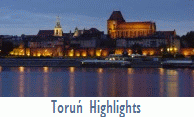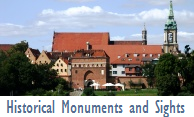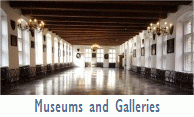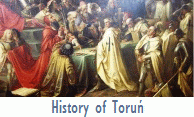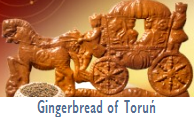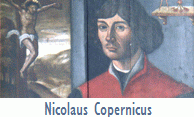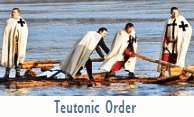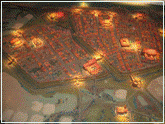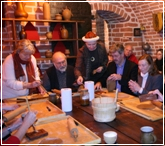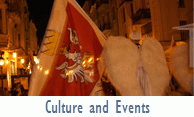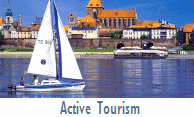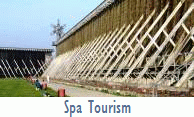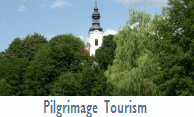|
Nicolaus Copernicus House Museum
Address: Toruń, ul. Kopernika 15/17 (15/17 Kopernika Street) Opening hours: High season (May - September): Tue - Sun: 10am - 6pm | Mon: closed Low season (October - April): Tue - Sun: 10am - 4pm | Mon: closed Admission fees (without reservation charge) Nicolaus Copernicus House: 12 PLN, reduced: 9 PLN Model of Medieval Toruń: 14 PLN, reduced: 9 PLN Nicolaus Copernicus House + Model of Medieval Toruń: 22 PLN, reduced: 15 PLN
Guided visit, further details: Toruński Serwis Turystyczny (Toruń Tourist Service), tel. (+48) 66 00 61 352, e-mail: muzeum@turystyka.torun.pl 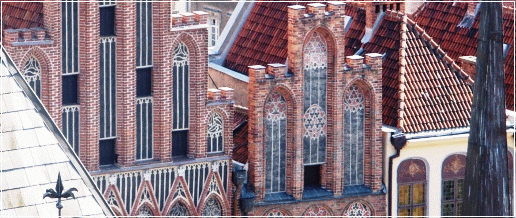 • About the edifices of the burgher houses see here.
• About Nicolaus Copernicus see here.
The museum is located in two Gothic tenement houses at 15/17 Kopernika Street. They used to belong to Nicolaus Copernicus senior, a merchant from Krakow, who moved to Toruń circa 1456, and by marrying Barbara Watzenrode from Toruń's patrician family, entered the elite of the town. The houses are considered to be the birthplace of the astronomer. They make a splendid Gothic complex of outstanding beauty as well as stylistic unity, especially after the conservation work. It made them possible to establish the museum of Copernicus' epoch, where visitors get acquainted with: the life and work of Copernicus, interiors of burghers' houses from the 14th to the 19th century, the look of mediaeval Toruń (the model) and gingerbread making. The burgher's house at 15 Kopernika Street is considered to be one of the most beautiful Gothic tenement houses in Poland. It is a representative of a popular dwelling-warehouse, common in the 15th century in towns along the south coast of the Baltic Sea, members of Hanseatic League (the association of merchant towns). There are several 14th century elements preserved in the building. Permanent exhibitions: 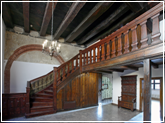 The merchant culture in Toruń in the times of Nicolaus Copernicus The merchant culture in Toruń in the times of Nicolaus CopernicusThe exhibition is presented in the most suitable place: thoroughly reconstructed interiors of the 15th century merchant house of the type called house-store, characteristic for the mediaeval towns of Hanseatic Community. The interior of the house is divided into two bays. In the ground floor the room of special significance is called the High Vestibule, which occupies the whole space, of the height of 5 m. It was used for living and trading purposes. Special attention should be paid to: multifunction joint leading to the cellars, into the yard, to the rear room and upstairs levels; the 15th century timber ceiling covered with the 17th century polichromy; and a spacious niche in the east wall, with the brims of moulding bricks painted red, which is a characteristic feature of vestibules in Toruń. In the south-western wing there is a partially reconstructed fragment of the kitchen with a hooded chimney, without the hearth. From the High Vestibule one proceeds into a room from the 2nd half of the 16th century, which is placed in the rear-bay. It has a flat ceiling with the 18th century polichromy and the décor (furniture, craft, paintings) from the 15th, 16th, and 17th centuries. The most interesting objects there are: a Gothic oak wardrobe from the turn of the 16th century decorated with opulent open-work wood-carving and polichromy, a brass christening bowl with the scene of Annunciation from the beginning of the 16th century, the globe of the Earth from the 17th century, and two paintings on wood: St Hieronimus in a cell, a 17th century copy of one of the most outstanding masterpieces by Albrecht Duerer, and Madonna with an infant among roses from the school of Jan Peter Bruegl (1628-1642). From The High Vestibule we can climb the 17th century steep stairs into a ballustarde, leading to the hung up cubicle built into (along with a lower cubicle underneath) the High Vestibule at the end of the 17th century - now there is an exhibition presenting a merchant's counting room. Above it in the first floor from the street side, there are two small rooms with a reconstructed pear shaped fire place from the 1turn of the 17th century and a fragment of west wall with brick surface of characteristic weft used in masonry in the 14th century. i 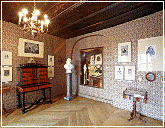 The Rappersville Exhibition The Rappersville ExhibitionThis exhibition - the only of this kind - is actually the reconstruction of the oldest collection of Copernicus memorabilia on display organized in The National Polish Museum in Rappersville, Switzerland, in 1870. The photography of the Rappersville exhibition along with numerous objects from Rappersville that are in possession of the Museum of Nicolauss Copernicus made it possible to organize the exhibition. On the basis of the photography, which enlarged version is a vital element of the exhibition, a room from the second half of the 19th century was reconstructed thoroughly, including even the wallpaper pattern. Among the objects on display the ones of special significance are the bust of Nicolauss Copernicus in white marble by Wiktor Brodzki (1826-1904), the facsimile of the first Nurnberg edition of 'De revolutionibus' (1543), and the first Polish, Warsaw edition of the above mentioned work (1854). i Visiting the Museum of Nicolaus Copernicus should start with the 18 minutes long performance: the light and sound presentation at the model of Toruń from around 1500. The scenario of the performance, in 8 language versions, presents the most significant events in the history of the city, its architecture and the layout in the 2nd half of the 15th century. It shows visitors dramatic events of wars between Poland and the Teutonic Knights' Order in the 15th century, and describes the significant role of our city in the conflicts.
• more details here >> i 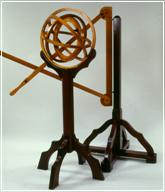 Nicolaus Copernicus. Life and Work Nicolaus Copernicus. Life and Work The exhibition consists of 6 parts, which are separate entities placed in the rooms of a double stroke tenement house. The first part, displayed in the High Vestibule of the building, introduces visitors to the atmosphere of Nicholas Copernicus' times, the times of great breakthroughs: apart from so called Toruń portrait of Nicolauss Copernicus (the 16th century) and the copper plates by Albrecht Duerer (1471-1528), it includes 'The World Chronicle' by Hartmann Schedl (1440-1525) with the woodcarving presenting the geocentric system and the model of the ship of Christopher Columbus.
The second part is devoted to the 15th century Toruń and the Astronomer's family; the third - the intellectual development of Nicolaus Copernicus during his studies in Krakow Academy (1491-1495), and in Italian towns: Bologna (1496-1500), Padua (1501-1503), and Ferrara (the facsimile of the note about Copernicus' doctorial thesis on canonical law from 1503 at the university of Ferrara is worth particular attention).
The forth part presents the birth and the history of the heliocentric theory (on one of the walls there is the enlarged copy of the solar system from the manuscript of 'De revolutionibus' serving as the background for the solar system model; the fifth part: the years the Astronomer spent in Frombork (1510-1543) where he held the post of the chancellor of the Chapter, a physician; in 1520 as the manager of the chapter properties he defended the castle in Olsztyn against the Teutonic Knights; apart from the above mentioned, he also initiated the currency reforms in Royal Prussia (in 1519 and 1522 he presented his treaty 'De aestimatione monete' during the session of Prussian parliament in Grudziądz) in addition he dealt with the issue of bread prices in Varmia region (in 1531 he elaborated so called 'Olsztyn bread tax') - moreover, he carried out the astronomical observations and was writing 'De revolutionibus'.
The sixth part, on the top floor of the house, presents the models of astronomical instruments used by Nicolaus Copernicus e.g. astrolabium, triquetrum, and quadrant. i 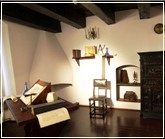 Study room of a scholar Study room of a scholar In 'our' study the central place is occupied by the table of a learned with a board, on which one can see books with astronomical tables and the reprint of the manuscript of "De revolutionibus…" - the most important work of the Toruń astronomer, which was published in print in the year of Copernicus' death i.e. 1543. In the right corner there is the genuine globe of Wilhelm Bleau with the 17th century map of the world. Above it there is the 17th century painting "A scholar in his study", considered to be of the highest artistic value in this room. The painting is believed to have been painted by Monogramist IS, the artist whose works show the influence of young Rembrandt and Gerard Dou. One of the first devices of this kind, an optical microscope from the break of the 16th and the 17th centuries serving scientists with naturalistic approach, is placed in the niche in the upper part, on the left side of the 16th century cupboard decorated with an interesting woodcarving presenting the Last Supper. i In the beautiful interior of the 15th century merchant house, typical for wealthy Toruń patriciate, you can visit the exhibition showing the everyday life of Toruń citizens on the turn of the 15th and 16th centuries. The stairs in the biggest room, the high entrance-hall, lead you to the Gothic cellars, where you can start visiting the exhibition presenting the history of famous Toruń gingerbread craft, which had its origins in the 14th century and flourished in the 17th and 18th centuries. The scenography arrangement lets you see the workshop of a gingerbread master, sitting at his desk and recording on wax boards stocks necessary for making honey and spice dough. Next to it there is the set of rules and regulations of the bakers' guild.
• more details here >> i
|
| All rights reserved Toruń 2005-2009 | About us | CenterMedia |




